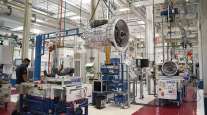Manufacturers Add 22,000 Jobs in March

President Donald Trump argues that he’s getting tough on China’s trade practices to keep domestic manufacturers from dying. One hole in that argument: American factories are coming back to life on their own.
U.S. manufacturers added 22,000 jobs in March, a Labor Department report showed April 6, making the six-month hiring spree the strongest since 1998. A total of 12.6 million people are employed in the sector, the most since 2008.
Steady hiring during this economic expansion has accelerated since Trump’s November 2016 election as businesses grew increasingly optimistic and global growth improved.
RELATED: Payrolls rise below-forecast 103,000 as wages pick up
Trump’s tariffs may threaten that trajectory. His administration proposed tariffs on $50 billion in Chinese products and is reviewing an additional $100 billion, on items from steel to factory goods, parts and chemicals — items U.S. companies need to buy to make things. A separate tax on imported steel and aluminum from some suppliers, which took effect in March, means some producers already are paying up.
China said it will respond proportionately. If the tough talk turns into more tariffs, U.S. manufacturers will feel the pain.
“Tariffs are one proposed response, but they are likely to create new challenges in the form of significant added costs for manufacturers and American consumers,” National Association of Manufacturers President Jay Timmons said in a statement earlier this week. “In addition to these challenges, tariffs also run the risk of provoking China to take further destructive actions against American manufacturing workers.”
RELATED: Trump’s tariffs hurting American factories as prices skyrocket
The March gains in manufacturing were led by the durable-goods category — items that last for at least three years such as metal products and appliances — an indicator of economic confidence.
The China tariffs, if implemented, also risk hurting parts of the country that were crucial to Trump’s election.
The levies could hit 2.1 million workers across 40 industries, especially in counties that voted for Trump in the 2016 election, according to data compiled by Mark Muro, a senior fellow at the Brookings Institution. The nonagricultural industries most at risk include pharmaceuticals, plastics, aircraft, autos and animal-slaughtering, said Muro, noting the data are approximate and may undercount some categories.




